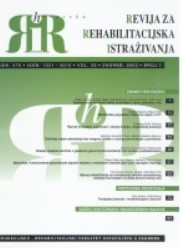Doživljaj uvjeta odrastanja kao moguća zaštita u razvoju poremećaja u ponašanju
Perception of Conditions for Healthy Development as Possible Protective Factor in Behaviour Disorders Prevention
Author(s): Valnetina Kranželić, Marija Lebedina-ManzoniSubject(s): Developmental Psychology, Psychology of Self, Behaviorism
Published by: Sveučilište u Zagrebu, Edukacijsko-rehabilitacijski fakultet
Keywords: children and youth; developmental assets; behaviour disorders prevention;
Summary/Abstract: Developmental assets were assessed by Questionnaire for self-assessment (modified by the faculty of Education and Rehabilitation Sciences, Department of Behaviour disorders, by original check-list, Leffert, Benson, Roehlkepartain, 1997) on a sample of 733 students aged between II and 18. The developmental assets model includes eight key categories: support, empowerment, boundaries and expectation, constructive use of time as external assets, and commitment to learning, positive values, social competence and positive identity as internal assets. The mentioned developmental assets can be looked at as optimal conditions for healthy development of children and youth. Nine factors were isolated in this research by factor analysis. Some of them describe family as an important environment for creating protective factors in development. School, neighborhood and local communities are also represented as support systems for students. Discriminative analysis was used to detect the differences between three categories of students: 5th-grade students, 6th-grade students (elementary school) and 4th-grade students (secondary school). The analysis showed two statistically significant discriminative functions. The main differences between those three categories are: (l) youn7er students perceived higher support and more empowerment; (2) secondary school students perceived lack of community support, low-level of responsible behavior and social competence. The results presented in this paper could be seen as a contribution to research in the field of child development and could lead to the conclusion that older children and youth perceive less developmental assets than younger children do. This fact might direct future efforts to create prevention programs with the aim of increasing protective factors and decreasing risk factors, respecting the age of the participants.
Journal: Hrvatska revija za rehabilitacijska istraživanja
- Issue Year: 38/2003
- Issue No: 1
- Page Range: 33-47
- Page Count: 15
- Language: Croatian

